01/29/20
K-State Current - January 29, 2020
K-State Current is a weekly news update for the Kansas Board of Regents to apprise the Regents on a few of the many successes and achievements made by K-State faculty, staff and students.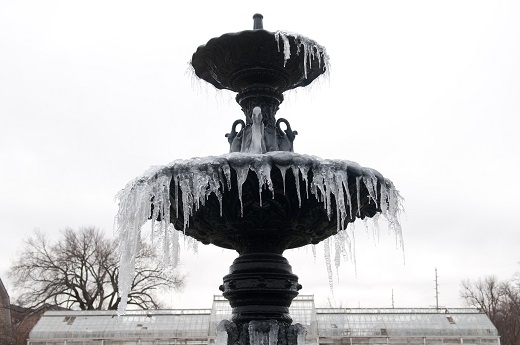
K-State News
K-State is the name and promoting higher ed is the game: University receives 43 CASE awards
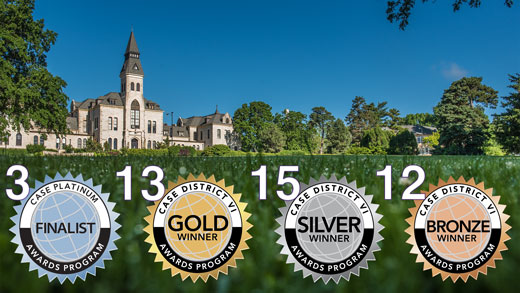 Kansas State University's creative communication teams collectively won 43 awards from District VI of the Council for Advancement and Support of Education for promoting higher education.
Kansas State University's creative communication teams collectively won 43 awards from District VI of the Council for Advancement and Support of Education for promoting higher education.
Kansas State University creative teams set a school record and earned 43 awards from District VI of the Council for Advancement and Support of Education, or CASE.
The awards highlight the best practices in alumni relations, fundraising, public and governmental relations, advancement services, special events and communications among an association of educational institutions. The awards will be presented at the District VI Conference Jan. 13-15. The district includes educational institutions in Kansas, Colorado, Iowa, Missouri, Nebraska, North Dakota, South Dakota and Wyoming.
"We continue to set new records with the number of awards won across the academy," said Jeff Morris, K-State vice president for communications and marketing. "This speaks to the high level of creativity and professionalism of our communications teams. We could not be more proud of our people."
The Division of Communications and Marketing received 16 awards; the K-State Alumni Association received 10 awards; and the KSU Foundation received 17 awards — three of which are platinum district finalist awards.
"The KSU Foundation team members demonstrate daily their ability to work as one to boldly advance Kansas State University," said Greg Willems, president and CEO of the KSU Foundation. "Awards like these exemplify what we can achieve together for K-State family."
The district finalist awards are for the fall 2018 issue of Good for K-State magazine: Your Questions Answered in the Best Practices in Communications and Marketing category; and All in for K-State day of giving in the Best Practices in Digital Communication category and Best Practices in Fundraising category. These three awards, also called platinum awards, are standardized across all districts and will advance to compete globally.
"K-State is continually recognized by its peers for high-quality work that helps alumni, friends, students, faculty and staff stay connected and engaged," said Amy Button Renz, president and CEO of the K-State Alumni Association. "We are honored to collaborate with our campus partners to support and advance higher education and the Wildcat community."
The teams also received 13 gold awards, 15 silver awards and 12 bronze awards:
Gold awards — A Cross-Cultural International Student Block Party in the Alumni Relations: Programming for Special Constituencies category; "The Hot Zone" event series in the Yearlong Special Events category; Experience K-State Polytechnic in the Short Recruitment Videos category; "Inspiring More," K-State TV spot in the PSAs and Commercial Spots Video category; fall 2018 Seek magazine in the Institutional Relations Research Publication category and Special Constituency Magazines category; spring 2019 Seek magazine in the Periodicals Design category; Open House poster in the Posters Design category; Gardens self-tour map in the Single-Page Publications Design category; Video box donor gift in the Specialty Pieces Design category; Advancing #AllInForKState campaign on social media and Kids Tell | Video Series, tied in the Best Uses of Social Media category; and the fall 2018 Good for K-State: Your Questions Answered in the Special Issues Magazines category.
Silver awards — 2019 K-State Alumni Association member calendar in the Calendars Design category; Ernie the Elf Holiday Social Media Campaign in the Best Uses of Social Media category; the KSUnite Issue of the K-Stater magazine in summer 2019 in the Special Magazines Issues category; November 2018 @K-State alumni e-newsletter and the January 2019 @K-State alumni e-newsletter tied in the External Audience Tabloid and Digital Newsletters category; K-Stater magazine collection of articles in the General News Writing category; "Live life Inspired" K-State Hype 2019 video in the Short Recruitment Videos category; fall 2018 Seek magazine in the Periodical News Writing category and Individual In-House Print Publications category; "Schools Girls" theatrical poster in the Posters Design category; summer 2019 issue of Good for K-State in the Editorial Design category; All In for K-State impact stewardship mailer in the Single-Page Publications Design category; fall 2018 issue of Good for K-State: Your Questions Answered in the Individual Fundraising Publications category; All In For K-State video trailer in the Short Fundraising Videos category; and the Passion + Purple Brand Anthem in the PSAs and Commercial Spots category.
Bronze awards — Spring 2019 issue of K-Stater magazine in the Covers Design category; Full Circle with Dr. King — Freshman to Board Chair in the Innovative Uses of Technology: Alumni Relations category; K-State Kansas City Wabash CannonBall in the Special Single-Day Events category; Influence Tomorrow — Generations of Innovators in the General Information Short Videos category; "The Hot Zone" advance screening in the Special Single-Day Events category; College of Business Administration website and Diversity and Inclusion website tied in the Complete Institutional Website category; Digital Development Officer in the Innovative Uses of Technology: Fundraising category; KSU Foundation Partnership Report for Fiscal Year 2018 in the Annual Reports and Fund Reports category; summer 2019 issue of Good for K-State in the Individual Fundraising Publications category; College of Architecture, Planning & Design — Thank You Donors in the Short Fundraising Videos category; and the 2019 K-State Medal of Excellence in the Long Fundraising Videos category.
Rural water wells in High Plains Aquifer show large increase in nitrate levels
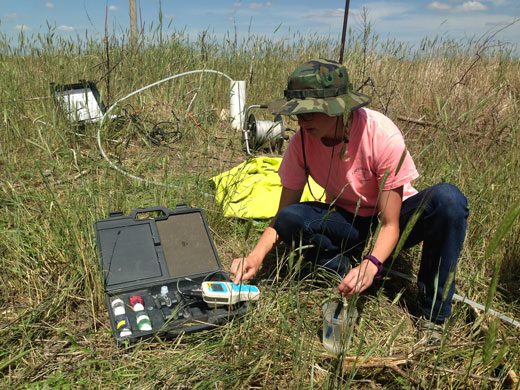 Kansas State University master's in geology graduate Allie Richard Lane samples water from wells as part of a 40-year comparison study of wells in the Great Bend Prairie Aquifer. The study has revealed water quality issues.
Kansas State University master's in geology graduate Allie Richard Lane samples water from wells as part of a 40-year comparison study of wells in the Great Bend Prairie Aquifer. The study has revealed water quality issues.
Kansas private well owners should test water quality annually, according to a recent Kansas State University study that revealed nitrate levels in shallow wells above U.S. Environment Protection Act standards.
"The changes we measured in the Great Bend Prairie Aquifer appear to be large relative to changes observed in a national study by the U.S. Geological Survey," said Matthew Kirk, Kansas State University associate professor of geology and the study's principal investigator.
The Great Bend Prairie Aquifer, a part of High Plains Aquifer, was the focus of a 40-year comparison study of rural water wells recently published in the Hydrogeology Journal. Kirk and Alexandria "Allie" Richard Lane, Kansas State University 2018 master's degree graduate in geology, published the study along with Donald Whittemore, Kansas Geological Survey; Randy Stotler, University of Kansas Department of Geology; and John Hildebrand and Orrin Feril, both with Big Bend Groundwater Management District No. 5.
"The Great Bend Prairie Aquifer is very vulnerable to contamination and if rural well owners don't know there is a problem, they obviously can't do anything about it," Kirk said. "Municipalities are required to test and provide safe drinking water for city residents but private rural well owners should take responsibility to test their wells at least every year."
According to Lane, who now works for the Kansas Department of Health and Environment, there are many kits that can be purchased online for under $40 that test for bacteria, pesticides, lead, copper, iron, nitrate and water hardness in water wells.
"Those kits are good to use for basic readings and if anything is concerning, then residents can send a sample to a lab for further testing," Lane said. "At KDHE, we try to inform private water well communities that it's important to test their wells annually."
Kirk and Lane's 2016 study measured water chemistries and compared them with 1970s measurements at the same sites. Twenty of 21 wells had increases of nitrate concentrations, or NO3-, compared to the 1970s samples. Seven wells exceeded the nitrate concentrations allowed by the EPA standard for drinking water. In the 1970s study, only one of the wells was above the current EPA standard.
"There hasn't been as much work on water quality as water quantity in the High Plains Aquifer," Kirk said. "Groundwater storage in the Great Bend Prairie Aquifer is relatively stable, but if the water is there and the quality degrades, that's also bad."
According to Kirk, high nitrate levels in drinking water can cause human and livestock health issues by interfering with transport of oxygen by blood and possibly causing a higher risk of cancer. Too much nitrate in groundwater can also stimulate a release of uranium and selenium from the sediment into the water. While water quantity may be a top concern for many rural areas currently, Kirk said water quality issues may soon rise to the top of the list of rural water problems.
"Other parts of the High Plains Aquifer are most likely going to see changes too but it's just taking it longer to show up because of transport time between the surface and the water table," Kirk said.
That transport time is fairly quick in the study area since the soil is sandy and the water table is closer to the surface, Kirk said. In addition, the aquifer and sandy soil are not ideal living environments for the microbes that help clean the water by consuming nitrate.
"Groundwater in the Great Bend Prairie Aquifer often has oxygen and where that is the case, microorganisms typically respire the oxygen instead of nitrate," Kirk said.
According to the study results, the wells with the highest contamination were those in fields used for crops, and the isotopic evidence — like a chemical signature — show that the nitrate in the aquifer is from fertilizer. Kirk said that fertilizers help farmers increase crop yields but excess fertilizer can contaminate water supplies.
"I don't know what the future looks like or how we balance these issues — growing food for the world and maintaining health of natural resources to grow that food — but we need to find ways to slow down nitrate accumulation and better manage nitrate into the future," Kirk said.
Kirk advocates for precision agriculture to apply fertilizer and planting cover crops — which use excess nitrate in the soil when planted in between the harvest of one food crop and the planting of the next. Kirk said these two practices help reduce runoff of excess fertilizer and are becoming more common with irrigated agriculture in the region. He also said that more studies are needed to evaluate if the drastic increase between the two time periods of the study is leveling off or if it has just ramped up in recent years.
"We need more data about the seasonal variation in nitrate levels and multiple years of data to really understand the trend of the increase," Kirk said. "We also hope to sample additional wells to evaluate change over more of the aquifer. We wanted to document this finding and try to spread the word because, at the end in the day, it's a big increase of nitrate and could affect people's health."
Support for the study was provided by a graduate student research grant from the Geological Society of America, the Kansas State University Department of Geology and the National Science Foundation.
K-State Faculty Highlights
Heier Stamm recognized as Professor of the Week
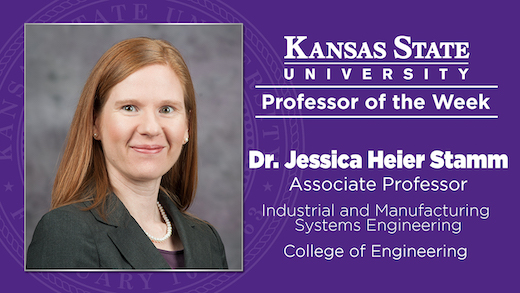 Jessica Heier Stamm, associate professor of industrial and manufacturing systems engineering in the Carl R. Ice College of Engineering, was recognized as Professor of the Week at the Jan. 18 men's home basketball game.
Jessica Heier Stamm, associate professor of industrial and manufacturing systems engineering in the Carl R. Ice College of Engineering, was recognized as Professor of the Week at the Jan. 18 men's home basketball game.
Heier Stamm joined the faculty in the industrial and manufacturing systems engineering department in 2010. Her teaching responsibilities include undergraduate and graduate courses in operations research, supply chain engineering, decision analysis and game theory. She is passionate about helping students discover the ways that they can make a positive impact in the world as industrial engineers.
Heier Stamm's research addresses challenges in humanitarian and public health logistics systems. This work is funded in part by a National Science Foundation CAREER Award. Heier Stamm collaborates with graduate and undergraduate students, as well as public and private sector organizations, including the Kansas Department of Health and Environment. This work is informing the ways that health care and public health organizations in Kansas manage supply chain decisions for disaster preparedness and response.
In addition to her role at K-State, Heier Stamm is currently serving on the board of the Public Sector Operations Research section of INFORMS, the Institute for Operations Research and the Management Sciences.
She is a K-State alumna, having earned her bachelor's degree in industrial engineering. The department's graduating seniors selected Heier Stamm as the Outstanding Teacher in 2013-2014, 2016-2017 and 2017-2018, and she won the 2016 College of Engineering Outstanding Assistant Professor Award. She was a Steve Hsu Keystone Research Faculty Scholar from 2017 to 2019, and is currently the Gisela and Warren Kennedy Cornerstone Teaching Scholar.
The Professor of the Week recognition is coordinated by Faculty Senate, the president's office, K-State Athletics and the Division of Communications and Marketing. Recipients are faculty members selected by Faculty Senate caucuses. Those selected are provided tickets to a men's home basketball game of their choosing and are recognized during halftime. This is a small token of appreciation for those who teach at K-State.
National Science Foundation grant to fund study of measuring emotions with cybersystems
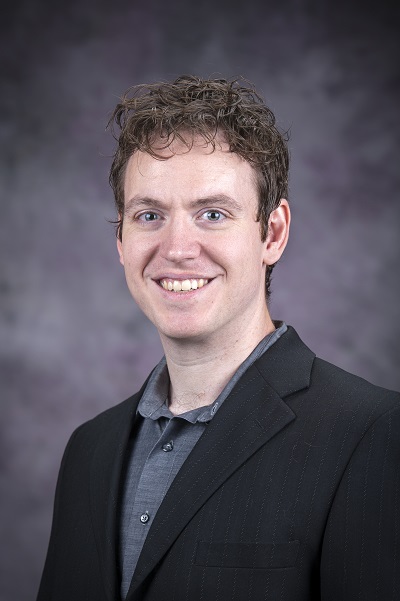 Emotions can heavily influence decision-making. To study the scope of this influence, a necessary first step is the ability to measure a person's emotional state. A project at Kansas State University has been recently funded by the National Science Foundation to develop and improve devices used for this purpose.
Emotions can heavily influence decision-making. To study the scope of this influence, a necessary first step is the ability to measure a person's emotional state. A project at Kansas State University has been recently funded by the National Science Foundation to develop and improve devices used for this purpose.
David Thompson, assistant professor in the Mike Wiegers Department of Electrical and Computer Engineering has been awarded nearly $500,000 by the National Science Foundation's Information and Intelligent Systems: Core Programs for his project "Enhancing EEG-based Emotion Estimation with Transfer Learning, Priming and Virtual Reality."
The Information and Intelligent Systems: Core Programs is part of the NSF's Division of Information and Intelligent Systems, which supports research and education projects that develop new knowledge in three core programs: cyber-human systems, information integration and informatics, and robust intelligence.
Thompson's project, funded under the Cyber-Human Systems Program, will lay the groundwork for devices that can be used outside the laboratory, from classrooms to theme parks.
"The normal way to measure emotion is by simply asking the person, but that takes time, causes interruptions and leads to false reports," Thompson said.
His research will consist of applying three techniques — transfer learning, semantic priming and virtual reality — to increase the performance and reliability of these emotion-measuring systems. A collaboration with Thinkwell, a global entertainment company, will also be included in the project.
Together, these investigations are expected to dramatically improve the performance and, critically, the cross-task reliability of these systems.
"Emotion affects nearly every field of human study," Thompson said. "Real-time measurement of valid emotions has the potential to cause cross-disciplinary transformation."
The project will support significant undergraduate and graduate research efforts of students from all backgrounds in the Carl R. Ice College of Engineering at Kansas State University, enriching the educational experience of all participants.
K-State Student News
Blue Key Senior Honorary wins national awards
![]() The Blue Key Senior Honorary chapter at Kansas State University was recognized in three separate national award categories at the 2020 Blue Key National Leadership Conference hosted at the University of Toledo.
The Blue Key Senior Honorary chapter at Kansas State University was recognized in three separate national award categories at the 2020 Blue Key National Leadership Conference hosted at the University of Toledo.
The chapter won the Outstanding Chapter Award, and two individuals received the Distinguished Service Award and Exemplary Member Award.
The 2020 Outstanding Chapter Award recognizes excellence in leadership, scholarship and service of the chapter through its actions and activities.
Rich Mistler, '62, is the recipient of the 2020 Blue Key Distinguished Service Award. The award is given in recognition to a Blue Key member, alumnus, or advisor who has served the society for a significant portion of the honoree's adult life. This award recognizes distinguished service and excellence in leadership, scholarship, service and character. This individual embodies the Blue Key motto, "Serving I Live." Mistler has been an active supporter for the Kansas State University Blue Key chapter. The chapter will recognize Mistler and honor him at one of its Catalyst large lectures in April.
Miranda Moore, 2018-2019 Blue Key class member, is the winner of the Exemplary Member Award. The award is presented to a member who has an exemplary record of leadership, dedication, commitment and service to Blue Key and their institution. The defining feature of this winner is that they have been a difference-maker who has enhanced the profile and reputation of Blue Key on their campus. Moore also served as director of public relations and outreach for the chapter.
Blue Key recognizes college students at senior institutions of higher education for balanced and all-around excellence in scholarship, leadership and service. At K-State, it is exclusively for students of senior standing for a one-year term. Several signature programs are organized through Blue Key, including Quest Freshman Honorary; Catalyst, a self-development class for underclassmen; DiscoverU, a conference for high school students in the AVID program; along with other programs and services such as scholarships. For more information about Blue Key, visit k-state.edu/bluekey.